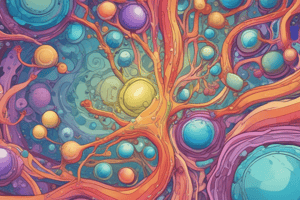Podcast
Questions and Answers
What is the main function of the cell membrane?
What is the main function of the cell membrane?
- To regulate the movement of substances in and out of the cell (correct)
- To store genetic material
- To provide structural support to the cell
- To synthesize proteins
Which organelle is responsible for generating energy for the cell?
Which organelle is responsible for generating energy for the cell?
- Ribosomes
- Lysosomes
- Mitochondria (correct)
- Nucleus
What is the main component of the cell wall in plant cells?
What is the main component of the cell wall in plant cells?
- Peptidoglycan
- Phospholipids
- Proteins
- Cellulose (correct)
Which organelle is involved in protein synthesis, transport, and storage?
Which organelle is involved in protein synthesis, transport, and storage?
What is the function of lysosomes in a cell?
What is the function of lysosomes in a cell?
Which organelle is involved in protein modification, sorting, and packaging?
Which organelle is involved in protein modification, sorting, and packaging?
What is the main function of the nucleus in a cell?
What is the main function of the nucleus in a cell?
What is the function of chloroplasts in plant cells?
What is the function of chloroplasts in plant cells?
What is the main component of the cytoskeleton in a cell?
What is the main component of the cytoskeleton in a cell?
What is the function of centrioles in animal cells?
What is the function of centrioles in animal cells?
Flashcards are hidden until you start studying
Study Notes
Cell Structure
Cell Membrane
- Thin, flexible layer that surrounds the cell
- Semi-permeable, allowing certain substances to pass through
- Composed of phospholipid bilayer with embedded proteins
Cell Wall
- Rigid layer outside the cell membrane in plant cells, bacteria, and some fungi
- Provides support, protection, and shape
- Composed of cellulose in plant cells and peptidoglycan in bacteria
Cytoplasm
- Jelly-like substance inside the cell membrane
- Contains water, salts, sugars, and various organelles
- Site of many metabolic reactions
Organelles
- Mitochondria: site of cellular respiration, generates energy for the cell
- Endoplasmic Reticulum (ER): involved in protein synthesis, transport, and storage
- Ribosomes: site of protein synthesis
- Lysosomes: contain digestive enzymes, break down and recycle cellular waste
- Golgi Apparatus: involved in protein modification, sorting, and packaging
Nucleus
- Controls cell growth, division, and reproduction
- Contains most of the cell's genetic material (DNA)
- Surrounded by a double membrane called the nuclear envelope
Cytoskeleton
- Network of protein filaments that provides structural support and shape
- Involved in cell movement, division, and signaling
- Composed of microtubules, microfilaments, and intermediate filaments
Plant Cell Specific Features
- Chloroplasts: site of photosynthesis, contains the pigment chlorophyll
- Vacuoles: large storage compartments for water, salts, and nutrients
- Plastids: involved in pigment synthesis and storage
Animal Cell Specific Features
- Centrioles: involved in the formation of cilia, flagella, and spindle fibers
- Cilia: short, hair-like structures involved in movement and sensing
- Flagella: long, whip-like structures involved in movement
Cell Structure
Cell Membrane
- Thin, flexible layer that surrounds the cell, maintaining cell shape and regulating what enters and leaves the cell
- Semi-permeable, allowing certain substances to pass through while keeping others out
- Composed of a phospholipid bilayer with embedded proteins that facilitate transport and cell signaling
Cell Wall
- Rigid layer outside the cell membrane, providing support, protection, and shape in plant cells, bacteria, and some fungi
- Composed of cellulose in plant cells, giving them strength and rigidity
- Composed of peptidoglycan in bacteria, providing protection and maintaining cell shape
Cytoplasm
- Jelly-like substance inside the cell membrane, making up about 70% of the cell's volume
- Contains water, salts, sugars, and various organelles that perform specific functions
- Site of many metabolic reactions, including glycolysis, fermentation, and protein synthesis
Organelles
- Mitochondria: generate energy for the cell through cellular respiration, producing ATP
- Endoplasmic Reticulum (ER): involved in protein synthesis, transport, and storage, and lipid synthesis
- Ribosomes: site of protein synthesis, where mRNA is translated into a polypeptide chain
- Lysosomes: contain digestive enzymes that break down and recycle cellular waste, maintaining cellular homeostasis
- Golgi Apparatus: involved in protein modification, sorting, and packaging, and lipid synthesis
Nucleus
- Controls cell growth, division, and reproduction, regulating gene expression and cell cycle
- Contains most of the cell's genetic material, storing DNA in a double-stranded helix
- Surrounded by a double membrane called the nuclear envelope, which regulates the flow of molecules
Cytoskeleton
- Network of protein filaments that provides structural support, shape, and mechanical strength to the cell
- Involved in cell movement, division, and signaling, and provides tracks for motor proteins to move along
- Composed of microtubules, microfilaments, and intermediate filaments, each with distinct functions
Plant Cell Specific Features
- Chloroplasts: site of photosynthesis, where light energy is converted into ATP and NADPH
- Vacuoles: large storage compartments that maintain cellular turgor pressure, storing water, salts, and nutrients
- Plastids: involved in pigment synthesis and storage, including chlorophyll and carotenoids
Animal Cell Specific Features
- Centrioles: involved in the formation of cilia, flagella, and spindle fibers, regulating cell movement and division
- Cilia: short, hair-like structures involved in movement, sensing, and signaling, and clearing debris from the cell surface
- Flagella: long, whip-like structures involved in movement, propulsion, and sensing, and regulating cell movement
Studying That Suits You
Use AI to generate personalized quizzes and flashcards to suit your learning preferences.




